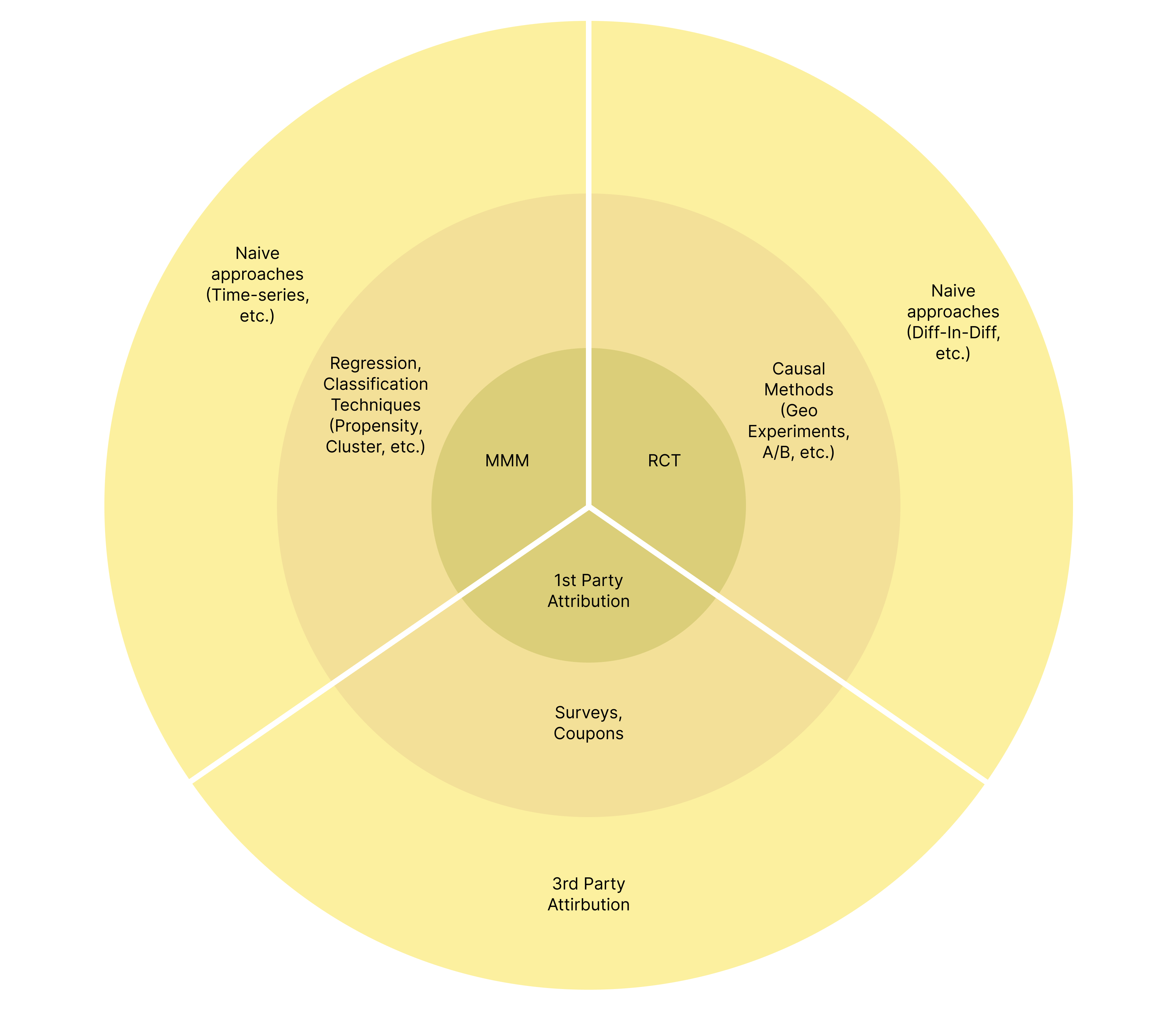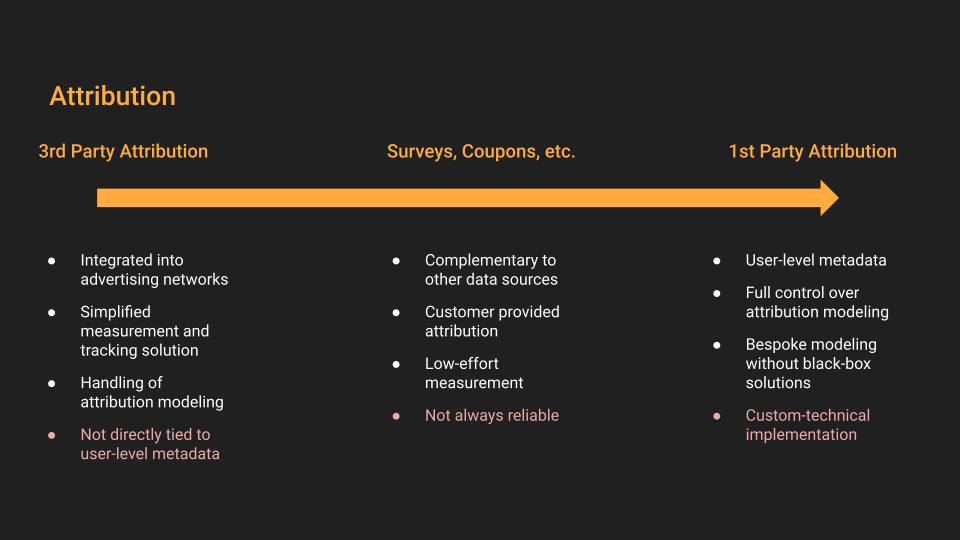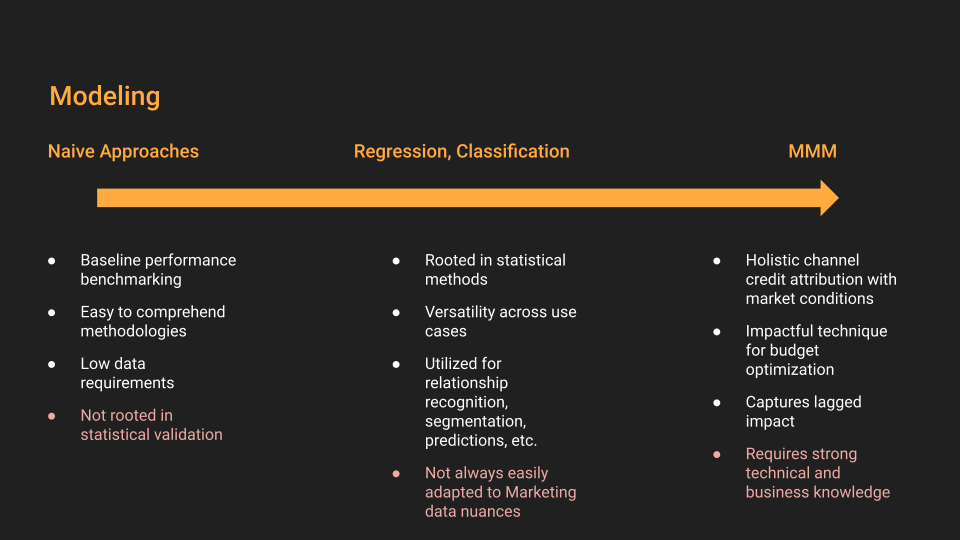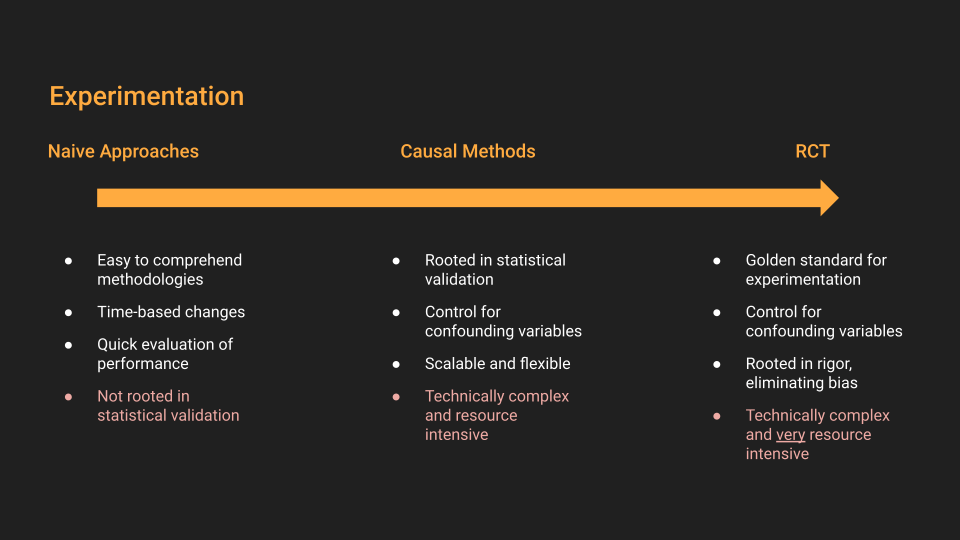In recent years, the evolution of growth marketing has driven the adoption of a diverse range of measurement techniques, both new and old. Where marketers once depended on a single source of truth, often through cookie-based tracking or a third-party vendor, they now rely on a combination of growth measurement tools and methodologies like surveys and causal inference. This combination has provided marketers with a more comprehensive and accurate view of how their marketing efforts contribute to business growth than what had been previously used, but it has also created more complexity and confusion.
Growth Analytics Measurement Frameworks
To simplify these modern growth measurement approaches, thought leaders in the space have come up with different frameworks to capture all of the commonly used measurement techniques today. The most recognizable frameworks in the space are Ben Dutter’s BEATS Framework and Recast’s Attribution Stack. They are nearly identical in the tools and methodologies mentioned, but are different in design. The biggest design difference between the two frameworks is that BEATS orders tools into categories that make a recognizable acronym, while the Attribution Stack builds on this categorization with a linear direction based on effort using similarly themed tools.
Both of these frameworks capture an accurate picture of today’s growth marketing measurement ecosystem, but I feel that both feel just short of creating an approachable visual for marketers of all skill levels. I think the Attribution Stack is more approachable by creating a visual communication of how much research and effort will be needed to move up the measurement stack, but it can be a bit overwhelming with the number of tools, levels, and categories mentioned. Trying to find the right balance, I created a three-level bulls-eye segmented by three broader categories of the tools defined within them.
Growth Analytics Measurement Bulls-Eye
I call it the Growth Analytics Measurement Bulls-Eye. The purpose of this framework is to help marketers of all skill levels understand how to think about progression through effort and impact without a firm understanding of potential paths forward. This nuance is captured through a visual design, simplification of the tool category groupings, and a guide below that helps you understand what considerations you should make and what natural stoppages in your journey to expect. Given that both articles linked do a fantastic job describing the tools mentioned here, I have omitted that from here and instead focused on the journey through the process.

The bulls-eye is segmented into, attribution, modeling, and experimentation. The uniqueness of the tools and methodologies distinguishes these labels. There are three rings (or levels) to the bulls-eye based on the effort and value potential that these tools can provide. Shared below are visuals to give you an idea of the tools in each ring for each segment, as well as their advantages and disadvantages.



Progression Through Impact and Effort
Now imagine the bulls-eye as a roadmap with the objective of advancing toward the center. The outer layer is the starting point due to the lower effort required to achieve quicker wins. As you move inward, each layer requires more effort but provides additional tools that when combined with the rest of the tools already in your measurement stack help provide you with a more accurate assessment of your marketing impact. This structure guides you on how to advance through each level with your own measurement strategy, but it doesn’t address navigating the categories of attribution, modeling, and experimentation.
Determining your strategy based on these categories is a little bit more complicated. The guiding principle is similar to the level progression in that you should navigate them based on your business challenges and ability to solve them with the tools on hand. However, there is an additional layer within this grouping that depending on the category will lead you to different answers to certain questions. Attribution is heavily reliant on deterministic information, modeling utilizes probabilistic techniques, and experimentation focuses on incrementality, providing different answers from the others.
It will take some time to research these tools and their applications to solve your business challenges, but to help with your journey it is recommended to always start with prioritizing attribution. Attribution requires minimal setup, is ideal for day-to-day reporting and optimization, and is likely something you have already incorporated into your marketing stack today. By leveraging attribution, you’ve already begun your measurement journey with minimal effort.
As your strategy evolves, you will arrive at business challenges and questions that cannot be answered with the attribution tools you utilize today. This will naturally lead you toward the tools within the modeling and experimentation categories that are better equipped in these cases and will complete your journey around the different segments of the bulls-eye. As a marketer or analyst, your role in moving around the bulls-eye is to lead conversations around these challenges and advocate for more sophisticated solutions to improve the efficiency of the marketing program that will create this measurement expansion.
Natural Stoppages
However, it is also important to understand that you might not be able to move through all of the levels in the bulls-eye for each category. Natural factors such as the business cycle stage, resources, or the complexity of your business may stop you at different points in your journey. For example, you might only run a few channels making the investment and feasibility of extracting value from tools within the center level of the bulls-eye is unlikely. Similarly, you might lack the expertise to accurately manage complex tools that fit under the marketing sciences umbrella which can lead to misleading results and being left worse off than where you previously were. In these cases, it is important to realize when things can be managed in-house or should be outsourced to experts, rather than pushing beyond your team’s comfort zone. Understanding the limitations and making strategic decisions around this can ensure that company resources aren’t wasted.
Conclusion
Navigating the digital marketing landscape today requires a comprehensive and adaptable measurement strategy. The Growth Analytics Measurement Bulls-Eye is one of many approaches to try and simplify the complexities of modern growth measurement with a structured and approachable visualization. Embrace the bulls-eye as a handy reference to chart your tool research and guide your measurement strategy evolution. With each step, you’re not only building a stronger measurement foundation but also setting the stage for future growth and impact.
Accompanying Presentation
This framework was shared as part of a presentation, Marketing Analytics in a Privacy-Focused World, I shared at the MeasureSummit conference. I have embedded the Google Slides presentation to see how this framework fits into the larger changes impacting marketing measurement.